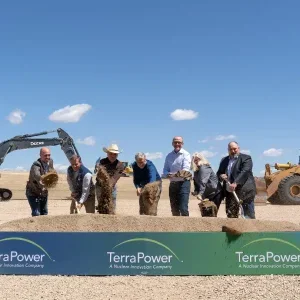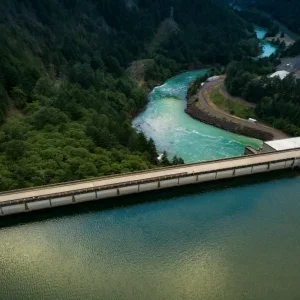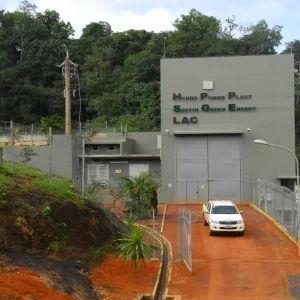Pumped storage will play an important supporting role in the US federal push to see more renewable energy projects developed. While economic bulk energy storage is the foundation of the pumped storage system, albeit at a net load cost to transmission grids, increasingly its features of rapid response and flexibility are finding fresh opportunity. The electric-power-research-institute (epri) has noted that the surge in interest in pumped storage is due, not least, to benefits it can provide to networks and facilitate stable operations when integrating other renewable resources, particularly fluctuating wind power. Other studies have also pointed to the potential gain from a combination of research on technological smaller scale plants and market needs to help support, for instance, local grids with significant wind power or even down to wind farms themselves.
There are financial opportunities to meet demand bursts as well as provide those stabilisation and support services, but the gain for a potential developer is dependent on particular market arrangements and conditions, especially for the longer term. Economics will always be a challenge, even in changing and liberalised energy markets. A recent benchmarking analysis, by edf’s David Surla, says that the percentage of pumped storage plants in liberalised markets is generally less than the economic optimal in most countries.
Distinct new ventures are however underway to build pumped storage schemes, such as the plans being developed by Riverbank Power Corporation in North America.
Riverbank Power
Riverbank Power is an independent power producer (IPP) with a concept – Aquabank –which it plans to use to build 1GW pumped storage plants across North America.
Each of the facilities calls for excavation of a half dozen caverns to form an underground reservoir and for the upper reservoir it can adopt various surface waters – flooded quarry, river, lake or coastal – depending on location. The Toronto-based company terms recirculation of water between tunnels and a flooded quarry ‘a closed loop’ arrangement, and all others are its diversion systems. Riverbank says there should be minimal effect on water and fisheries caused by operation of Aquabank facilities, although further studies will be conducted.
Typically, the powerhouse and underground reservoir will be excavated at a depth of a little over 600m, and will cover 10-12 times that of the surface structures. The power plant will house four, 250MW single-stage reversible Francis pump-turbines, and Riverbank is investigating the potential of variable speed drives for various possible benefits, such as increasing overall plant efficiency, load following during pumping, and smoother operations.
Beyond site-specific design for each project location, no additional R&D is required as all components have been proven, it says. However, it does note that model tests will be conducted for the first pump-turbine to confirm the basic design for use in Aquabank. Once comfortable with the basic design, only refinement for application in separate projects would then be required, it adds.
The optimum size of the Aquabank system, at 1GW to provide six hours of generation, has been reached from examining a range of variables, including construction costs and financial return. The finance model also takes account of possible ancillary services and capacity payments, though each project’s potential offering to customers would depend on where it is located and where it connects in to the grid.
Each project has an estimated cost of US$2B and the construction phase is envisaged to last four years. The company will seek both equity and debt funding to finance the projects, and its primary investor is BlackRock. It will, though, look at possibilities for federal funding support in light of the US Government’s aims to push renewable energy development.
Riverbank says it has agreements with various firms in environmental, hydro power, civil, excavation and turbines manufacture. Details were not disclosed but on its website, for the planning work and studies, it has mentioned geological consultant Continental Placer, environmental consultants Stantec and Malcolm Pirnie, and other consultants covering hydrology, mining design and project managers – Groupe RSW and SNC-Lavalin. Support on price forecasting and market intelligence is provided by Energy Security Analysis and London Economics International.
Differences
The concept of water recirculation with an underground reservoir is not totally new (see box: Some earlier Closed Loop PS proposals). In the 1990s, there were private sector plans for a one-off project of 2GW capacity at Mt Hope, New Jersey. While it has not yet been built the most recent plans had seen a re-think with the concept altered to a 1GW, multi-stage underground scheme.
Riverbank notes the superficial similarities to Mt Hope of water circulation to an underground reservoir and powerhouse, and the convergence in scale, but says the prime differences relate to environmental aspects, the energy market, community support and grid access – and emphasises that location is a vital factor in selecting sites. Should one of its projects be built in the next few years then it says it would be the first to combine pumped storage with deep excavation.
However, beyond any aspects of similarity to a previous concept, Riverbank’s proposals are different to what has been conceived before by a major order: it aims to rollout a portfolio of Aquabank plants in North America, and possibly beyond. But it will be no little challenge as the first candidate site, at Sparta in New Jersey, was eventually determined to have unsuitable geology. Presently, the main focus on project development is at a potential site in Wiscasset, Maine.
Wiscasset
The project site at Wiscasset was announced by Riverbank in late 2008 and the current plan is to have the facility online in 2015, a year later than initially stated.
Riverbank is developing the project through a subsidiary, Riverbank Wiscasset Energy Center, LLC. It says the pumped storage scheme would help the state to meet its goals of improving the reliability of the grid and integrating up to 3GW of wind generation by 2020.
Located on land bought five years ago by Connecticut-based property firm National Resources from Maine Yankee Atomic Power Co, the scheme is to be a diversion system, the upper reservoir being the tidal Black river. The company contends that there should be minimum effects on the quality and temperature of water temporarily diverted underground during generation and returned in pumping operations.
It is estimated from the outline design that approx. 215m3/sec would be diverted to the pump-turbines, each of which will have a rated capacity of 254MW at 514 rev/min. The nominal net head is approximately 550m. The capacity of each motor-generator is 278MVA.
The lower reservoir would consist of six caverns, each approximately 27m wide by 47m high, and excavated to free-stand in unlined rock. Site investigation began a year ago and test drilling was undertaken by Boart Longyear.
Geology in the area is dominated by the Cape Elizabeth Formation, which is schist. At the range of depths for the powerhouse and caverns, the rock was found to be predominantly granitic gneiss with good to excellent rock mass rating based on core sampling. Packer tests in boreholes showed little water absorption. Further site investigation has been underway.
Sparta
Poor rock quality terminated Riverbank’s hopes for a pumped storage plant at Sparta, which was one of the top candidate sites. It would have been a closed loop system.
The proposed site for the scheme was Limecrest Quarry, which it was agreed with the owner would have formed the upper reservoir with water being circulated with the lower reservoir, excavated in the bedrock approximately 610m below.
The company was cleared at the beginning of the year to begin site investigation and environmental assessment studies. Riverbank’s programme called for the plant to be operational by 2015. However, within months of the studies getting underway, the data from the initial drill tests showed the strata to be unsuitable to host the powerhouse and six large storage galleries.
Riverbank announced the project was cancelled in August – only two months after the Federal Energy Regulatory Commission (FERC) had issued a preliminary permit and cleared the way for a priority application.
Portfolio Plans
With progress ongoing at Wiscasset, and despite the Sparta setback, Riverbank Power Corp is pushing ahead with its plans to develop a range of sites in North America that will result in a portfolio of 1GW facilities.
The company has looked at more than 50 possible sites in North America and continues with the work. So far, Riverbank has found 15 sites that meet its initial selection criteria, and disclosure of candidate sites will only be announced when sufficient progress is made, including planning support. Its main areas of focus are the northeast US and Canada.
There are four main criteria Riverbank uses for an early judgment on the development potential – geology, hydrology, distance to transmission grid and community support. Passing these criteria enables disclosure of a candidate project site, and then in-depth studies commence with drilling and testing into the bedrock, environmental assessment and evaluating the energy market and transmission capacity.
Riverbank aims to develop five of the pumped storage plants over the next few years. While originating in, and focused on, North America, Riverbank would also consider developing project in other countries, said Kuo-Bao Tong, project manager of the Wiscasset site and who also helped oversee early development progress on the other candidate sites.
| Closed Loop pumped storage proposals |
One of the earlier proposals to excavate an underground reservoir for a grid-scale pumped storage project in the US was to have been at Mt Hope, in New Jersey. The plant was initially conceived as a 2GW facility. A more minor endeavour, in size if not ambition for its replicability, was the concept for distributed, or modular, pumped storaget (DPS) systems, such as that envisioned for the 200MW Brink project, in Utah. |






